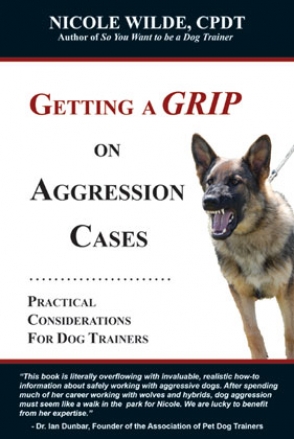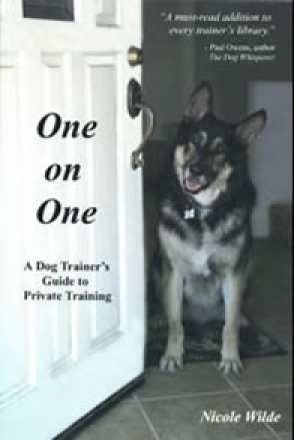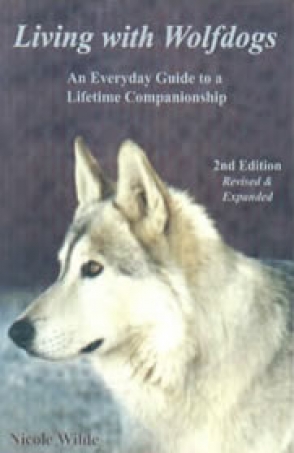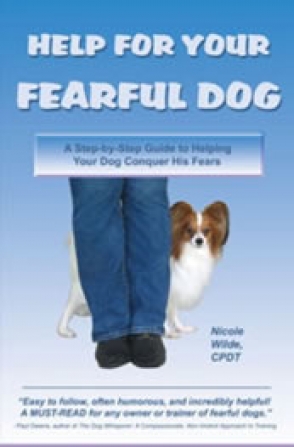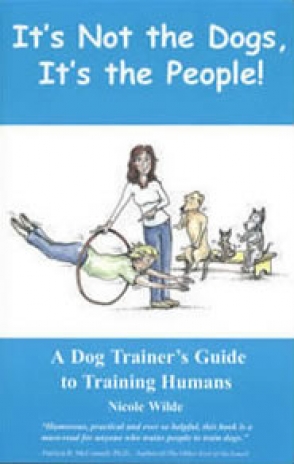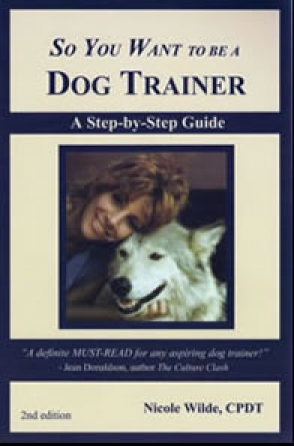There is a lot more to working with aggression cases than mastering methods and techniques.
Living with Wolves
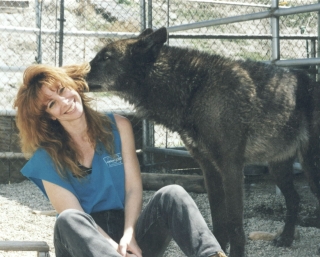
My last and dearest wolf, Phantom, passed away last week. But rather than making this piece yet another eulogy, I’d like to share with you a bit of what it’s like to live with wolves.
Before I begin, you’re probably wondering why anyone would live with wolves—or have wolves living with them—in the first place. Some people get wolves as “pets” because they want a piece of the wild, or feel connected to wolves on a spiritual level. Some simply love them and want to share their lives with them. In my case, I had been working with a wolf and wolfdog (wolf hybrid) rescue for many years, and I fell in love with a big, black, green-eyed wolf named Phantom.
A man who lived in a suburban neighborhood in southern California had purchased Phantom from out of state with the intent of selling him. This man brokered wolves, selling them to anyone who could afford them, no questions asked. He sold Phantom three times, only to have him returned each time because Phantom would not let anyone touch him. His penchant for jumping six-foot fences in a single bound didn’t help, either.
The rescue center I worked with was aware of this man, and I befriended him so that I could keep tabs on the welfare of the eight wolves who resided in his back yard. The first day I entered the makeshift enclosure, Phantom and I saw each other—and it was love at first sight. I was sitting on the ground petting him and getting face kisses when the man exclaimed, “Well, that’s never happened before!” Just like dogs, wolves do pick their people. I’ll never know how I got so lucky that Phantom picked me. When the man was eventually issued an order by animal control to get rid of the wolves, I begged my rescue partner (on whose ten-acre ranch the rescue sat) to take Phantom in. She agreed, on the condition that I would find a way to house him myself as soon as possible. Within a year my husband and I bought a house, built a pen, and moved the now three-year-old Phantom in. Soon after that we brought Heyoka and Sequoia over from the rescue to keep him company. Heyoka was also a three-year-old male and was 75% or so wolf mixed with malamute. (I wouldn’t have normally brought in a male of the same age, but I knew they would get along.) Sequoia was a lovely, attention-seeking six-year-old Samoyed/wolf mix who gave new meaning to the term alpha bitch. She ruled those boys! The pen was expanded to become an enclosure, and the three became a pack.
I can describe housing wolves in two words: extremely difficult. Our enclosure was built around what was meant to be a group of horse stalls. It’s approximately 30’ x 70’, with a corrugated metal roof. We covered every inch of the ground with rolls of chain link, then secured them to the 9-gauge chain link panels that made up the walls of the enclosure. The ground was then covered with dirt, followed by pea gravel. The roof was attached to the sides with yet more chain link, and a hot wire was set up around the top inner perimeter. A perimeter fence was then built a few feet out from the main enclosure. There were chains. There were padlocks. And there was a “catch pen” within the main pen to make it easier in the event that one of them needed to be crated up to go to see the vet. You might wonder why we went to all that trouble. Another two words: escape artists! People are often surprised at how easily wolves can dig their way under, jump over, or eat their way through pretty much anything in their path. I have seen wolves chew through 11-gauge chain link without a problem. At least we were prepared.
Although I’d always been able to pet Phantom, it did not mean I could handle him like a dog. Having always had what I can only describe as a bratty teenage personality (and I say that with love), Phantom began to test me immediately. He’d walk up behind me as stealthily as his big, gangly body would allow, and grab for the ponytail holder in my hair; he’d shove me gently as he walked by; he’d nip at my clothes. To be perfectly honest, I was a bit intimidated at first to address the issue.
One day I stood in the enclosure chatting with a friend who was outside. Suddenly, I felt a crushing pain in the back of my knee, and blood trickling down inside the leg of my jeans. I spun around to see my three fur-kids standing in a line, all looking at me innocently as if to say, “Who, me?” But I knew it had been Phantom. This is where I must confess, dear readers, that my gentle, positive training approach took a temporary leave of absence. I was not a happy camper, and I was in a lot of pain. Drawing myself up to my full 5’2”, I stormed over to Phantom and yelled a string of words that should never, ever be used in dog training. All I wanted was for him to look away and down to indicate, “Whoops, sorry, Mom.” Didn’t happen. So, I did what I would recommend that no one ever do; that is, I kept moving forward and yelling until I had him cornered. Glowering, I issued a few more choice words in a low, throaty voice. He finally looked away.
With my dignity considerably more intact than my leg, I huffed my way out of the pen and up the 38 stairs leading to the house. I put a bag of frozen peas on the back of my knee. There were no puncture wounds, but the tissue was crushed. I would soon be sporting a large, black and blue, golf-ball sized projection. At my friend’s suggestion, I took a few deep breaths and some Rescue Remedy (which I must say works especially well in tequila). After that, I began to work with Phantom on handling and other issues, and we soon established a loving, balanced relationship. Over the years I became able to handle his paws, his teeth, and anything else that needed handling—for the most part. Again, he was a wolf, not a dog, and having started this behavior modification at the age of three months rather than three years would have been helpful.
Phantom had the most wonderful, deep howl. It sounded like a foghorn. Whenever I’d drive my Jeep up the long driveway to the house, Sequoia would begin a joyous, welcoming howl and the boys would join in. The harmony was beautiful.
My husband and I had built a tall wooden table in the pen, with shorter tables on either side. The wolves loved to chase each other around the pen and jump up on this jungle gym. (There was also all manner of enrichment added over the years—hay bales, electrical spools, you name it.) I’d climb on to the shorter table, pull myself up on the taller one, and then pat the table next to me. In a graceful blur, Phantom would be beside me. I’d pet him as he walked back and forth on the table, arching his back and soaking up the petting like a giant cat. But my favorite thing was to give Phantom tummyrubs, especially when he’d go “full tummy” on his back, gangly limbs flailing in the air. I was often afraid he’d flail right off the table top, but it never happened. Those tummyrubs, and the long sessions we’d have just hanging out on the floor of the enclosure with the other wolves, were some of the best times of my life. Phantom was so incredibly special, and he became very trusting of me over the years. We really did have an incredible bond.
Sequoia passed away two years ago, and Heyoka, this February. Although I’d tried to introduce Phantom to two eligible female bachlorettes from the rescue so he wouldn’t be alone, he hadn’t gotten along with either one. But he wasn’t alone—I spent time with him every day, and spoiled him rotten with all manner of delicious wolfy treats and lots of love. Sadly, we had to put Phantom down on October 22nd, less than a month after my beloved dog Mojo passed. Phantom was 13 ½ years old and had been with me for more than ten years. I still expect to see him when I look down at the pen. But Phantom will live forever in my heart, and it was an incredible blessing to spend so much of my life in the company of wolves—one large, green-eyed bratty one in particular.

